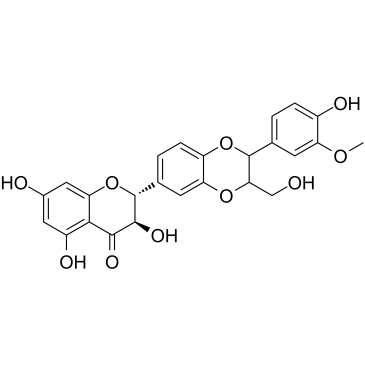
Isosilybin
CAS No. 72581-71-6
Isosilybin( Isosilybinin )
Catalog No. M19043 CAS No. 72581-71-6
Isosilybin and Silybin might be suitable candidates to design potent PXR antagonists to prevent drug-drug interactions via CYP3A4 in cancer patients.
Purity : >98% (HPLC)
 COA
COA
 Datasheet
Datasheet
 HNMR
HNMR
 HPLC
HPLC
 MSDS
MSDS
 Handing Instructions
Handing Instructions
| Size | Price / USD | Stock | Quantity |
| 5MG | 61 | In Stock |


|
| 10MG | 95 | In Stock |


|
| 25MG | 205 | In Stock |


|
| 50MG | 383 | In Stock |


|
| 100MG | 565 | In Stock |


|
| 200MG | Get Quote | In Stock |


|
| 500MG | Get Quote | In Stock |


|
| 1G | Get Quote | In Stock |


|
Biological Information
-
Product NameIsosilybin
-
NoteResearch use only, not for human use.
-
Brief DescriptionIsosilybin and Silybin might be suitable candidates to design potent PXR antagonists to prevent drug-drug interactions via CYP3A4 in cancer patients.
-
DescriptionIsosilybin and Silybin might be suitable candidates to design potent PXR antagonists to prevent drug-drug interactions via CYP3A4 in cancer patients.
-
In VitroThe reporter gene assay shows that milk thistle’s components silybin and isosilybin are responsible for the inhibition of PXR-mediated CYP3A4 induction by milk thistle. Compared with silybin, its isomer isosilybin is a stronger inhibitor of PXR-mediated CYP3A4 induction. A solution of 89, 133, and 200 μM isosilybin significantly inhibits CYP3A4 induction by 64, 82, and 88%, respectively. Isosilybin inhibits CYP3A4 induction with an IC50 of 74 μM. Isosilybin B and isosilybin A, two diastereoisomers isolated from silymarin, have anti-prostate cancer (PCA) activity that is mediated via cell cycle arrest and apoptosis induction. Isosilybin B and isosilybin A treatment results in growth inhibition and cell death together with a strong G(1) arrest and apoptosis in human prostate cancer LNCaP and 22Rv1 cells. Isosilybin B causes increased phosphorylation of Akt (Ser-473 and Thr-308) and Mdm2 (Ser-166), which is linked with androgen receptor degradation as pretreatment with PI3K inhibitor (LY294002)-restored androgen receptor level. Isosilybin B treatment enhances the formation of complex between Akt, Mdm2 and AR, which promotes phosphorylation-dependent AR ubiquitination and its degradation by proteasome. Isosilybin A is able to significantly activate PPARγ at a concentration of 30 μM (2.08±0.48 fold, p<0.01). Isosilybin A causes transactivation of a PPARγ-dependent luciferase reporter in a concentration-dependent manner. In silico docking studies suggests a binding mode for 3 distinct from that of the inactive silymarin constituents, with one additional hydrogen bond to Ser342 in the entrance region of the ligand-binding domain of the receptor.
-
In Vivo——
-
SynonymsIsosilybinin
-
PathwayOthers
-
TargetOther Targets
-
RecptorCYP3A4
-
Research Area——
-
Indication——
Chemical Information
-
CAS Number72581-71-6
-
Formula Weight482.44
-
Molecular FormulaC25H22O10
-
Purity>98% (HPLC)
-
SolubilityDMSO : ≥ 28 mg/mL; 58.04 mM
-
SMILESC1(C(C(=O)c2c(cc(cc2O1)O)O)O)c1cc2OC(C(Oc2cc1)c1cc(c(cc1)O)OC)CO
-
Chemical Name——
Shipping & Storage Information
-
Storage(-20℃)
-
ShippingWith Ice Pack
-
Stability≥ 2 years
Reference
1. Chung PY,et al. Identification, by gene expression profiling analysis, of novel gene targets in Staphylococcus aureus treated with betulinaldehyde. Res Microbiol. 2013 May;164(4):319-26.
molnova catalog



related products
-
DEPTOR-IN-1
DEPTOR-IN-1 is an inhibitor of DEPTOR with a Kd of 9.3 μM.
-
BTB-1
BTB-1 is a novel small molecule inhibitor of the mitotic motor protein Kif18A.
-
Diathesin
It is an organic compound with fomulaa C7H8O2.



 Cart
Cart
 sales@molnova.com
sales@molnova.com


